Hannu Mikkola in Kenya Safari Rally reunion with his Audi 200 Quattro
Last time I met Hannu Mikkola was in the Southern Hemisphere, and here we are again. Kenya this time, rather than Patagonia and fewer flights to get here, though the one from Nairobi in a tiny Cessna isn’t one I’ll forget in a hurry. Still, when you’re invited to share a car with a legend such as Hannu, crossing the globe is no big deal. Rally drivers get around. Always have. Even retired ones.
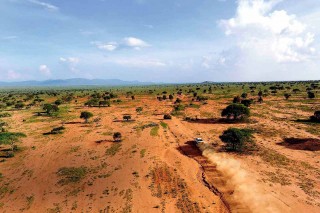
He takes the front seat next to young Curtis the pilot, who is courteous and polite. Turns out Mikkola’s a slightly nervous passenger, somewhat wary of certain fixtures and fittings that might not have passed scrutineering in his game. I can’t afford to be a nervous passenger, either now or later, so I occupy my mind with the view over dusty, red plains, circular Maasai villages, and the looming hulk of Mount Kilimanjaro. Journeys are rarely as startling as this, visually or otherwise. Same goes for the destination: the Taita Hills, which erupt from the plain in the south-east of Kenya, just 3º south of the Equator.
We’ll come back to the destination later. What about the occasion? Well, it’s 30 years since Mikkola’s last WRC victory. It was with Audi, in the 1987 East Africa Safari Rally. And the car’s here too, that very same Group A Audi 200. You know, the big executive saloon. The aerodynamic one. Famed for thrusting bosses along the autobahn between high-powered meetings, its Quattro four-wheel drive and lusty turbo five-cylinder perfect for dismissing distance in all weathers. Ideal, too, for the dusty plains of the Savanna. And all the other wildly varying terrains of this vivid country.
‘It was a big shock for everyone, coming to Group A from Group b. After Group b, you just had to remember that the other cars had less power, too. I’ve competed in cars from 60bhp to 550bhp; it’s always just as difficult to win,’ says Hannu. ‘With less power, the hard part is to keep the car going. With a powerful car, you drive more with the throttle. With less power, you don’t have that option. If the brake balance is right, you play with that and you get into a rhythm. You brake to get the back end up. It comes without thinking, really.’
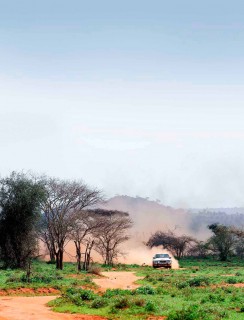
A masterclass from the 1983 Group b champ. Only in 1987, Group b was no more. The era of the fire-breathing rally cars had come to an end after too many deaths – drivers, co-drivers and spectators – and concerns that safety considerations were being overridden by the desire to win. Audi had withdrawn before the FIA intervened, and Hannu hadn’t competed in a rally for more than a year when, together with Arne Hertz – the co-driver he’d shared cars with since 1977 – and still with the Audi team, he made his comeback in Group A.
Yet why, when Audi had come so far with the coupé Quattro, did it turn to the 200 saloon? Also here in Kenya is Dieter Basche, former racing driver and head of Audi Sport during the Group A years. ‘We had Group A Quattros, though they were not homologated with a turbo. The 200 was, so it was an easy decision. Sure, it was a big four-door, but everybody within Audi loved it as a road car, and we hoped that would help.’
‘It’s bigger so it’s less nervous, it doesn’t twist so quickly, it accelerates less hard and so you don’t need to steer so much,’ adds Hannu. ‘If a car looks right, it’s often good to drive too. I have lots of good memories of the 200; I drove it in three rallies, and finished third or fourth in Greece. I crashed it in Finland…’
‘We had so much experience in developing Group B, which had more power and higher speeds. It made our jobs a lot easier for Group A,’ says Dieter. ‘We were confident we could make a good car of the 200. But the challenge to the suspension was the same. With less power, the car has to handle even better if it’s not to lose time. Throughout Group B there was a steep learning curve of development, and a team of 60-80 people rather than the 12 or so we’d have had in the 1970s. By 1987 there were 200 people in Audi Sport, working across three different projects. They would organise local people for servicing and back-up trucks. They knew best.’
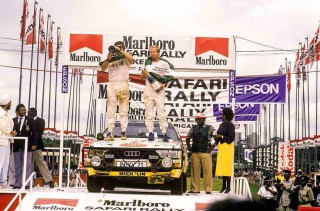
Of course, Audi built more than one 200 rally car, although this one – which survived its victory on the 1987 Safari – is the only one still with the company. ‘We had a car that could win the Monte, we had a car that could win the Safari,’ says Dieter. ‘For the Safari, the structure was reinforced, and we had special spring and damper settings. We added material in crucial areas – you had to follow the original shape and dimensions. Thickness was limited; we had to weld sheet metal into places such as the front suspension mounts, subframes and firewall. We raised the car 20-25mm on longer springs and spacers, and we fitted progressive springs at the front. There were tougher wishbones at the back, too. The front struts have altered geometry, reinforced seals and a range of temper settings from Boge, because of the temperatures.’
The strengthening aspect was extremely difficult for Audi philosophically because it added weight. ‘The aim for road cars was efficient aerodynamics and saving weight. That’s not what this was about!’ says Dieter. ‘Normally you work out where to add strength and where to take away weight. Here the first aim was to go the distance without a problem. And you have to consider safety. Once we tried to use aluminium for the rollcage, reducing the weight higher up where it makes the most difference. But people have to be safe inside the car. We went back to steel…’
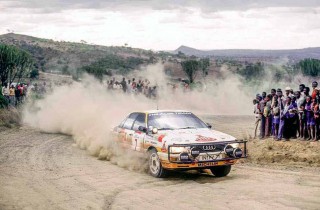
Clockwise from left 30 years on, kicking up a dust-storm in the Maasai Mara; Hannu Mikkola and co-driver Arne Hertz, triumphant in 1987; on their way to victory.
Audi was very sensitive to that aspect, especially considering the price Group B had levied in so many cases. And with the main aim being to last the distance, the Safari car carried extra equipment that wasn’t required on other rallies: ‘There’s a bull-bar at the front and a 200-litre fuel tank – it’s normally 120 litres; the stages here are much longer than most. There’s extra lighting too. At night, in Kenya, it really goes dark.’
A special heavyweight jack was signed off only when Hannu suffered a puncture during practice and left the tyre-changing to Dieter. ‘The lightweight jack just wouldn’t lift the car off the mud!’ he smiles, exchanging a wry look with Hannu.
Our conversation takes place at a lodge a few miles from the town of voi, along a ridge just south of the Taita Hills, which conceal one of this giant continent’s few remaining unspoilt areas of rain forest. The view is one of the most panoramic in Africa, stretching miles across the plain. On the western horizon, Kilimanjaro’s snowcap peeks above the haze. The springtime rains have come early, so there’s much greenery in evidence, but still the red earth dominates. Wildlife is in abundance. Between the airstrip and here – just a couple of miles – we’ve seen elephants, antelope, zebra and buffalo. Lions, it’s reckoned, prowl through the grounds of the lodge at night. Maasai herdsmen can be seen with their nomadic cows. screaming, snarling, sideways rally cars are furthest from your mind in a place like this.
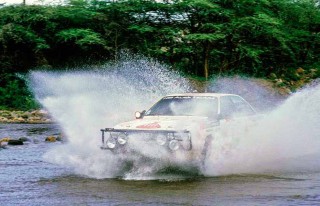
Above and below Maasai tribesmen were clearly elated to see Hannu and the Audi; quickest way to cross a river, back in 1987.
Hannu breaks our reverie: ‘The safari rally was the most varied of the WRC events, long and high-speed. normal traffic was a problem, there was lots of dust and broken-down cars were left everywhere. in the lead you didn’t feel tired. But if you dropped back you’d feel it. and then you had to motivate yourself to fight back.’ it was one of the trickiest too. ‘in 1987 less than half the field finished. They didn’t cancel any stages; if there was flooding, you just had to get through or go round. it can take seven hours to get to the other side of a swollen river.’
The 1987 safari rally was the first endurance event to be held under the new Group a rules, and Audi became only the second non-Japanese manufacturer to win it in a nine-year period. Hannu had won the event in a Ford escort back in 1972, the first non-African to do so. in 1987, he beat by some distance his team-mate Walter Röhrl, making for an Audi one-two – and Audi’s first win since Sanremo in 1985. it was a Gruelling seven-day rally, covering 2491 miles over every imaginable terrain, with 958 miles on competitive sections, all on unsurfaced roads that remained open to traffic; 26 controls were visited in darkness.
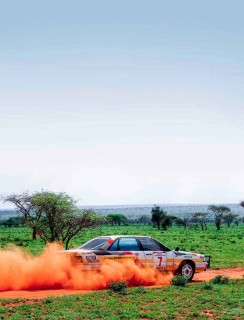
Hannu quickly took over from Stig Blomqvist’s early lead. The swede was unwell, taking part in a local car commandeered by the Ford team after his own was crashed before the start. and as was so often the case, Japanese cars were soon vying for supremacy, particularly Björn Waldegård in his Toyota supra.
Says Hannu: ‘I thought Toyota was our main competitor but they weren’t any faster than we were. i was quite surprised. Toyota had spent a lot of time concentrating on the safari rally and won it many times.’ trouble struck, though, when an engine problem cost Hannu time and two positions, dropping him back to third. ‘a turbo pipe fractured,’ he says. ‘We got it fixed and it increased our speed quite a lot. We had two punctures too, but we just drove faster than before. We weren’t far behind, just 12 seconds by Nairobi. Then Toyota couldn’t get a driveshaft off and my service went well. suddenly I was leading again.’
Service teams weren’t always on hand either, due to the great distances covered on each stage. ‘Arne and myself once stopped to plug the radiators. We had front suspension problems, electrical problems. But we were lucky to have service in the right places. You can be lucky – and we were – but you will have problems, that’s for sure.’
Unusually, Dieter was there for the 1987 event, too. ‘We had radio contact,’ says Hannu. ‘I’d lost some speed. So I read the gauges, fed the information back to Dieter. They concluded it was a turbo pipe.’
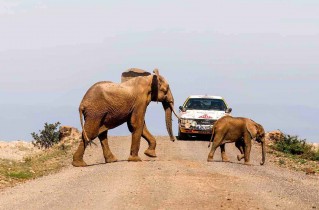
Dieter interjects: ‘I tried to catch as many service points as possible, usually one or two every day. I remember a service where we changed the shock absorbers – we hadn’t found a way to make them last the distance – and it went better than when we’d ever done it before. Everything went to schedule. But much of it is down to luck. You get one stone stuck in the wrong place and you service the car with a hacksaw, not a spanner.’ Of course, as the head of Audi Sport, Dieter couldn’t be on hand in all rallies.
‘I couldn’t always be there – I had to be developing the next car. Jörg Bensinger [the man credited with the idea for developing the Quattro system for Audi’s road and rally cars] said I should be there, and I didn’t always like it. But it was a good opportunity to be closer to the competition and I gained much experience from it. And nowhere is more difficult than Kenya.’
We’ve crossed the landscape in a convoy of Land cruisers, clambering down the rocky road from the lodge. Here, sitting in the midst of the red plain we were looking across, is the 200. Hannu was ahead of us, and has already taken his sighting laps. It’s an area that held an official stage towards the end of the 1987 event but such are the tracks criss-crossing the dusty earth that it would be foolish to ask Hannu if he ‘remembers these roads’. In fact, his sighting laps have familiarised him with a 12km stretch. As I’m about to find out, knowing where to turn out here, with only trees as landmarks and no signage, is a skill as valuable as car control.

Hannu’s already strapped in and I scrabble over the rollcage into the passenger seat. No racesuits today, as the temperature’s a heady 32ºc outside and it’s way hotter in here: the Audi 200 always was known for cooking its occupants under that flush glazing. We’re in helmets though, with proper rally intercom, and tightly strapped into five-point harnesses.
There’s dust everywhere, a red layer you could leave finger trails in on every surface: a corollary of those sighting laps with the windows down. ‘On the rally, we closed everything and ran the fans, so the air pressure inside was higher than outside,’ he says, then cranks that turbo five into life. There’s the familiar warble, Hannu grabs first (it’s a conventional ’box, straight from the road car) and we topple along the grassy tufts and make for the track. Then he accelerates.
That warble builds to the familiar buffalo-bellow, and there’s a hint of turbo-whistle too, yet it’s all strangely undramatic. The ride smooths out until it feels like a jet plane through turbulence, and the pace builds strongly, but not savagely. A couple of trees make for an impromptu chicane and I brace my feet in the footwell: Hannu doesn’t brake, he simply flicks right to unsettle the tail, then left into the chicane, right again through it and left out of it, the tail plotting our course more than the wheel. It’s very different to last time: a 360bhp Group B Quattro A2 on Patagonian tarmac is so much more visceral an experience than this, but that’s the difference between Group B and Group A, I guess. The 200 has 240bhp. And a surface you can slide across rather than thru-ppeny-bit your way over with every change in vector.
‘On the Safari there’s different grip, different driving styles, from one stage to the next. It’s loose here, like driving on ice. Very different from asphalt,’ says Hannu, grabbing his breath between shocks from the rutted surface. Suddenly, he hangs a left and I can see the track spearing towards the horizon: long, straight, relatively free of obstacles. I’d seen the red rooster tail he created on his practice lap earlier; now it’s building behind us as Hannu makes his way back up from a snatched downshift into second, and we find ourselves in fourth, closing in on the rev limiter and into fifth as the Audi reaches the kind of speeds executives might once have enjoyed in one on the autobahn. Only we couldn’t be further from an autobahn.

Clockwise from top left Elephants are less of a hazard now than 30 years ago; Octane’s Glen Waddington strapped in for a thrilling ride with Hannu Mikkola; stripped interior still recognisable; five-cylinder engine is 60bhp more powerful than the 180bhp road car’s.
The car’s stability is incredible, as is its feeling of utter integrity: those extra layers of steel clearly do their job, even 30 years on. And Hannu is utterly at home here, even in his mid-70s. Skills like these don’t simply disappear. Indeed, as he’d told me earlier: ‘I have never given thought to how I drive. It just comes. All my life, it just came by experience.’
All too soon, we can see again the crew in the distance as our 12km low-level flight comes to an end. One last blast through the gears, another chicane, then a right-left flick and we start to decelerate. It’s hot in the car, yet the atmosphere is relaxed. We’ve travelled at speeds that you’d normally suggest are unnatural over this terrain, yet in the 200 – and next to Hannu – they felt entirely appropriate. So I’m stirred, though not really shaken. As Dieter had said earlier: ‘The philosophy at Audi was to make the car as forgiving as possible. If the car is easy to control, you lose less concentration over a distance.’ Clearly, that’s important when you have 958 miles of special stage to cover. Flat-out.
Audi’s famous for, among other things, rally cars and executive saloons. Who would have thought the two could be combined to such brilliant effect.
TECHNICAL DATA FILE SPECIFICATIONS 1987 Audi 200 Quattro Group A C3
Engine 2144cc five-cylinder, OHC, Bosch KE-Jetronic fuel injection, KKK K26 turbocharger with intercooler
Power 240bhp @ 6000rpm / DIN
Torque 243lb ft @ 4000rpm / DIN
Transmission Five-speed manual, four-wheel drive
Steering Rack and pinion
Suspension Front: MacPherson struts, lower transverse arms, coil springs, telescopic dampers, anti-roll bar / Rear: Double wishbones, coil springs, telescopic dampers, anti-roll bar Brakes Vented discs.
Weight 1400kg
Top speed 130mph (est)
0-60mph 8.0sec (est)
‘SUCH ARE THE TRACKS CRISS-CROSSING THE DUSTY EARTH THAT IT WOULD BE FOOLISH TO ASK HANNU IF HE “REMEMBERS THESE ROADS”’





